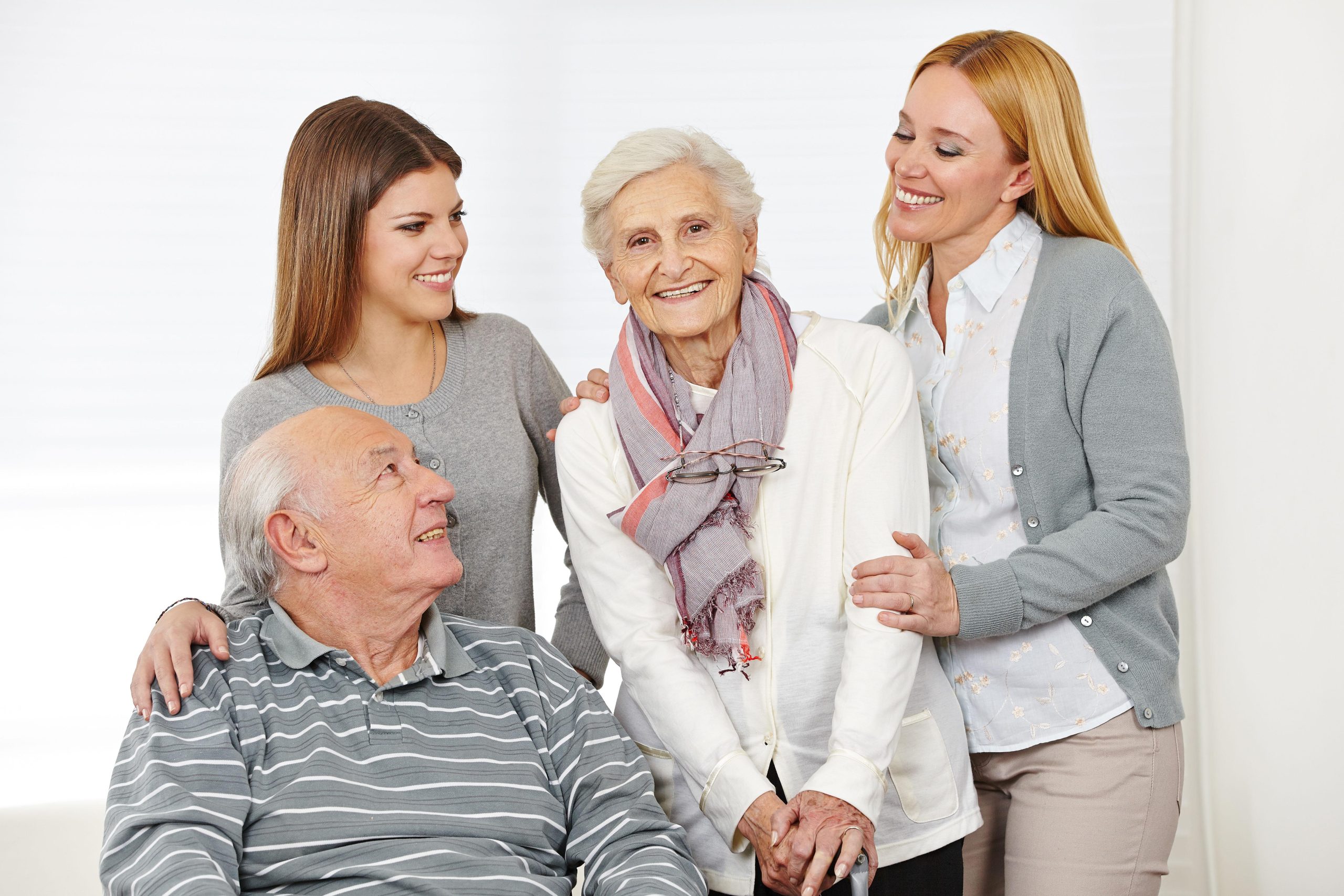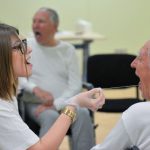Medically reviewed by Diana Apetauerova, MD
Fact checked by Zerah Isaacs
If you have Parkinson’s disease, you probably realize that all of your relationships – those with your spouse, partner, family, friends, colleagues, and acquaintances – can change. They can change in a good way (you renew and deepen a connection) or in a bad way (you completely lose a relationship).
The most important thing to remember when reflecting on how Parkinson’s influences your relationships is that you have some say in the matter. While you cannot control how people react to your condition, you can speak up when people start to treat you in ways that are incompatible with your dignity or independence.
Decide How to Handle Your Relationships
It is difficult enough trying to navigate complex relationships when you are healthy and in good spirits. But it is even more difficult to navigate relationships when you do not feel 100% well – when your mood is down and you are filled with anxiety about your condition, your future and that of your family.

Nevertheless, navigate these relationships you must – and you will, one way or another. You can choose to be proactive and positive in your approach to others. Start by deciding how you want your relationships to grow over the course of your disorder. You probably want to be able to receive love and support, as well as give love and support to those around you.1
You do not want to apologize for your disorder. It is not your fault. It happened, and now all of those around you need to come to terms with it. If you find that certain people cannot accept it, remind yourself that this is their issue to contend with.
The one exception to this rule? Children. You will need to find a way to help children come to terms with your illness. But adults should have the grace not to burden you with unnecessary outbursts of anger or denial. Your Parkinson’s is now a fact of your life and it must be accepted.
Video: “Rehabilitation of the patients with Parkinson’s Disease”
SET OF EXERCISES №1 FOR PARKINSON’S DISEASE: IMPROVING JOINT MOBILITY AND INCREASING BODY FLEXIBILITY
For additional information about Rehabilitation of the patients with Parkinson’s Disease you can watch a video demonstrating exercises and rehabilitation recommendations.
Expect Stages of Grief
Of course, those who love and those who have invested in you may react initially with grief, anger, and disappointment. Those stages, however, should not continue indefinitely. Your loved ones need to learn that you are still you and that the relationship can still go on.
Over time, as your Parkinson’s disease progresses, your contribution to the relationship will change or may even diminish, but that is entirely understandable. Even relationships among healthy people undergo dramatic changes over the course of the years. Why should a relationship with someone who has Parkinson’s be any different?
In short, people around you need to come to terms with your disease and its implications for the relationship.2 Once they do so, the relationship will grow and may even nourish both of you just as it always had done.
The work your friends and family must do after you receive the diagnosis is clear: They must come to terms with your condition and learn that you are still the same old you. Those close to you must further decide how involved they can be in your care when you need help.
The work you must do on all of your relationships is different. You must learn how to maintain your relationships despite being relentlessly ‘pursued’ by your disease. Each relationship will require a different set of responses from you in order to maintain it and to keep it healthy.
SET OF EXERCISES №2 FOR PARKINSON’S DISEASE: STRENGTHENING OF THE MUSCULOSKELETAL AND MUSCULAR SYSTEM, ENDURANCE
Your Most Important Relationships: Your Spouse and Yourself
The most important relationship you will have throughout your Parkinson’s is your relationship with yourself. You will need to find ways to nourish your spirit despite much adversity. You will need to find an inner spiritual core that can sustain you while you struggle to maintain a normal life despite Parkinson’s daily intrusions.

No one can tell you how to do this. No one but you knows what really recharges your batteries and imparts to you inner calm, strength, and fierceness. Whatever that thing is, that thing that gives you strength and a zest for life, you will need to nurture it and rely on it both to fight the illness and to keep your other relationships healthy and nourishing.3
The second most important relationship for you, if already part of your life, will be your ‘significant other’ – your spouse, partner, or primary companion. This person is the one who will witness your hardest moments and your brightest. You have got to find ways to graciously accept all of the help your companion is willing to give to you. You also need to learn the ropes of coping with Parkinson’s together. As much as you can, help that person learn about Parkinson’s, keep spirits up and remain intimate with you.
Your partner needs you and you need your partner. Rejoice in that fact. Believe it or not, Parkinson’s disease and its challenges can actually deepen and strengthen your relationship.
Parkinson’s disease can have an impact on the relationships you have – sometimes for the good, sometimes not. But there are things you can do to deal with the effects your condition can have on connections with those close to you and foster the continuation of healthy and happy bonds.
A SET OF EXERCISES №3 FOR PARKINSON’S DISEASE: IMPROVING THE COORDINATION AND “COMPOSITION” OF MOVEMENT – DIVIDING IT INTO COMPONENTS
Parkinson’s and Your Spouse or Partner
Schedule regular open, honest and frank discussions with your significant other. Give your partner room to voice frustrations not only with Parkinson’s disease but with you. Talk about money issues on some sort of regular basis as well, as issues like this can very easily create background anxiety in even the best of times.
The two of you should consider some sort of couples therapy or regular meetings with some trusted, impartial observer who can provide a forum for sharing frustrations and ideas on how to overcome those frustrations. You need to be able to talk about the inevitable role changes that occur when Parkinson’s enters the picture.4
When you were healthy, perhaps you both worked and made near-equal amounts of money, but now perhaps your contribution to the family’s finances is not as great as it once was. If this is the case, your spouse might need to work more – at a time when he or she also needs to put in more time to care for you and your needs. How do you feel about this? How does your partner feel? Talk it out and, if need be, talk it out with a counselor.
It is amazing how effective talking can be. Just sharing feelings and fears can resolve a million problems. If your spouse is stressed at all the new obligations she faces in caring for you, you, in turn, feel depressed by your helplessness. Sharing your feelings with one another will defuse any resentment that tends to build in reaction to the pain and stress you both inevitably feel.
Finally, try to maintain your independent lives. Don’t allow your partner to adopt a mere caretaking role. Partners should have their own friends and activities. Encourage your partner to keep up those activities – things that re-charge the batteries and feed the soul.
Likewise for you. Having Parkinson’s does not mean you suddenly lose interest in everything and everyone else. Keep up your hobbies and interests. Keep growing. Parkinson’s can slow you down, but it can’t keep you from growing intellectually and spiritually.
A SET OF EXERCISES №4 FOR PARKINSON’S DISEASE: BALANCE, GAIT IMPROVEMENT AND FALL PREVENTION
Your Relationships With Close Friends
Just as your relationship with your significant other can change after you receive your diagnosis, so too can your relationship with all of your friends. Some will gradually diminish their interaction with you. Most will not. Your friends will need to learn from you what you can do and what you can no longer do.

Your best bet in keeping those friendships healthy is to give your friends the clear facts about Parkinson’s. Tell them that you want them to help you maintain your independence for as long as possible, which will likely mean at least 15 to 20 years after you receive the diagnosis. Tell them that as time passes you will likely face greater challenges from the disease but that you wish to maintain the relationship.
You will be tempted to let people go, especially during those times when you feel down and out. But if you can find a way to avoid self-pity and depression, you will stand a better chance of staying nourished from your friendships. Your friends will bring you a lot of joy if you let them.5
Remember: Your relationships with significant others, family members, and friends are a vital source of happiness, comfort, and joy. Keep yourself invested in all these relationships. Go the extra mile and cultivate them with passion and energy.
Friends and family are the most important thing in life. They can help you face and meet the challenge of Parkinson’s disease. Surprisingly, although Parkinson’s will undoubtedly put a strain on your relationships, the condition itself may ultimately bring you closer to your family and your friends.
By Patrick McNamara, PhD
Patrick McNamara, PhD, is an associate professor of neurology and the director of the Evolutionary Neurobehavior Laboratory.

Physiotherapy and rehabilitation
Rehabilitation methods for Parkinson’s disease, prescribed by a qualified specialist in physiotherapy and rehabilitation, combined with drug therapy, can significantly improve the quality of life of patients, improve motor and cognitive functions, and reduce the symptoms of the disease.
To maintain the health of patients with Parkinson’s disease, it is important to combine different operations and activities. Every day, you can combine and vary as follows – strength training, walking training, exercise bike training, training to improve joint flexibility, improve posture and balance. Of course, it is important to combine training with daily activities and, therefore, to practice the functions used in everyday life: sitting, getting up (from bed, from a chair), mobility in bed, etc.
The process of rehabilitation and treatment of patients with Parkinson’s disease, of course, depends on the disease stage (primary or progressive). But regardless of this, the process of developing and forming a rehabilitation program should take into account four main areas:
-
Improve joint mobility and increase body flexibility
-
Strengthening the musculoskeletal and muscular system, endurance
-
Improving the coordination and “composition” of any movement – dividing it into components.
-
Improve balance, gait and fall prevention
As recent studies have shown, for patients with Parkinson’s disease, it is important to form a rehabilitation plan based on a stepwise, gradually changing training rhythm and increasing exercise difficulty. Constancy and monotony in the choice of physical activity and activity is not recommended.
Check out the demo version of our sets of exercises for Parkinson’s Disease on YouTube
Our website presents the following sets of exercises for the rehabilitation of the patients with Parkinson’s Disease:
-
SET OF EXERCISES №1 FOR PARKINSON’S DISEASE: IMPROVING JOINT MOBILITY AND INCREASING BODY FLEXIBILITY
-
SET OF EXERCISES №2 FOR PARKINSON’S DISEASE: STRENGTHENING OF THE MUSCULOSKELETAL AND MUSCULAR SYSTEM, ENDURANCE
-
A SET OF EXERCISES №3 FOR PARKINSON’S DISEASE: IMPROVING THE COORDINATION AND “COMPOSITION” OF MOVEMENT – DIVIDING IT INTO COMPONENTS
-
A SET OF EXERCISES №4 FOR PARKINSON’S DISEASE: BALANCE, GAIT IMPROVEMENT AND FALL PREVENTION
FREQUENTLY ASKED QUESTIONS
1. How do Parkinson’s disease symptoms differ between men and women?
Men are more likely to have Parkinson’s related cognitive problems than women and more severe problems with freezing gait, drooling, and bent spine.4 Women are more likely to suffer from fatigue, depression, restless legs, pain, and tremors, and they have a higher risk of falling.
2. Is loss of a sense of smell a sign of Parkinson’s disease?
Yes. Loss of smell is common with Parkinson’s disease, but other conditions can cause it, too.5 Your sense of smell gradually lessens over time, so you may not realize it’s diminished until you’ve already developed other symptoms.
3. Do all people with Parkinson’s disease shake uncontrollably?
About 80% of people with the disease experience tremors.6 Characterized by involuntary quivering movements, these “resting tremors” occur when you’re not moving.
Sources
https://www.verywellhealth.com/impact-of-parkinsons-disease-on-relationships-2612111
- Artigas NR, Striebel VLW, Hilbig A, Rieder CR de M. Evaluation of quality of life and psychological aspects of Parkinson’s disease patients who participate in a support group. Dement neuropsychol. 2015;9(3):295-300. doi:10.1590/1980-57642015DN93000013
- Navarta-Sánchez MV, Riverol M, Ursúa ME, Ambrosio L, Senosiain JM, Portillo MC. Psychoeducational intervention for people with Parkinson’s disease and family/carers: Preliminary results at baseline time. Revista Científica de la Sociedad de Enfermería Neurológica (English ed). 2019;49:16-22. doi:10.1016/j.sedeng.2018.08.001
- Pickut B, Vanneste S, Hirsch MA, et al. Mindfulness training among individuals with Parkinson’s disease: neurobehavioral effects. Parkinson’s Disease. 2015;2015:1-6. doi:10.1155/2015/816404
- Martin SC. Relational issues within couples coping with Parkinson’s disease: implications and ideas for family-focused care. J Fam Nurs. 2016;22(2):224-251. doi:10.1177/1074840716640605
- Takahashi K, Kamide N, Suzuki M, Fukuda M. Quality of life in people with Parkinson’s disease: the relevance of social relationships and communication. J Phys Ther Sci. 2016;28(2):541-546. doi:10.1589/jpts.28.541
Additional Reading
- Parkinson’s Disease: Diagnosis and Clinical Management: Second Edition Edited by Stewart A Factor, DO and William J Weiner, MD. 2008 Demos Medical Publishing.








